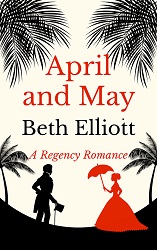Interview with Regency Author, Beth Elliott
Hello, Beth, welcome to my blog.
Hello Lynette. Thank you for inviting me. It’s lovely to have a chat.
You write Regency Romance and have recently had a book published by Endeavour Press called, ‘April and May’, could you tell readers a little about your book?

Four years earlier Tom and Rose met and fell in love but both families disapproved and they were parted. They meet again in Constantinople. Circumstances force them to work together on a secret project. Rose now has a new admirer, handsome Kerim Pasha, the Sultan’s chief minister. Back in London, Tom and Kerim Pasha carry out their secret mission, with threats of violence never far away. Both wish to win Rose but it takes her a long time to understand her own feelings.
Is this your first book? Do you have any plans to write and publish any other books?
I’ve written six stories set in the Regency period. April and May has just been published as an e-book by Endeavour Press. It’s my first story using Constantinople [now Istanbul] as a setting, although the plot moves to London later on.
My next story, Scandalous Lady, is set entirely in Constantinople. That’s the story of an ice cold diplomat who meets a rebellious artist and thereafter, nothing goes to plan.
Who was your favourite character in ‘April and May’? And why?
I love all my main characters – no favourites, although I do have a soft spot for Sebastian. There’s a plot all ready for him to have his own story soon.
Is there any sort of theme throughout your book?
Very simply: If at first you don’t succeed, try, try again.
Did you learn anything from writing the story?
In terms of crafting the story there’s always more to learn. I feel pleased with some of my scenes but conveying character, events and setting while keeping the story flowing is a never-ending process.
Where do you usually write?
I have a small study [very untidy with books and papers in heaps] and prefer to write on the desktop, then edit on printed out pages. It gets messy!
Where’s the strangest place you’ve ever written?
When I stay with my long time French friend, she puts me in her study to write while she carries on with her endless DIY. [She has an enormous old farmhouse]. Every now and then she sticks her head round the door and asks ‘Are you writing?’ As she’s always holding either a hammer, an electric screwdriver or a saw, you bet I’m writing. It’s like that cartoon on Facebook where the stick figure with the gun says ‘Just write the damned novel’.
Tell me a little about your writing day…
I’m a night owl. In the day I may do research but the actual writing starts about 9pm and goes on until I run out of ideas or the characters get stroppy. They normally cooperate until at least midnight.
Do you have any writing advice for would be authors?
Writing is not easy but don’t get discouraged. Never throw anything you have written away. In a few days you’ll find something in there that is worth developing.
Which authors have you been influenced by?
I always loved tales of long ago and far away. As a child, Robert Louis Stevenson’s stories fired my imagination, and in a completely different vein I enjoyed Jane Austen. Then I sneaked my mother’s Georgette Heyer stories. I also like Louise Allen, Nicola Cornick and Loretta Chase. Then there’s Mary Balogh and Diane Gaston and, again showing an inclination for travel and adventure, Bernard Cornwell’s Sharpe stories – after watching the delectable Sean Bean in the TV films of them.
Can you tell readers something about yourself that would either amuse/interest/or surprise them?
I studied French and Italian [in England] and went to teach at a university in France. There I met my Turkish husband. He had also studied French and Italian [ in Turkey]; so we had two languages in common but then we both had to learn each other’s own language to speak to the members of our families.
If you could be anything other than an author, what would that something be?
An archaeologist. It involves history, travel and breathless excitement when you discover unexpected items from so long ago. You’ll notice there’s a whole family of archaeologists in April and May.
Finally, can you tell readers where they can find your books and where they can find your website/social media links online?
The best way to find my books is via my website www.bethelliott.webs.com.
There’s a link there to my Amazon page as well as to Endeavour Press www.endeavourpress.co.uk
I have a Blog called Regency tales – http://Regencytales.blogspot.com. It’s mostly a well illustrated scrapbook of research for my stories, with a few interviews and travel notes.
I’m also on Facebook as Beth Elliott and on Twitter as @BethElliott.
Thanks for answering my questions and good luck with your new book!
Thanks to you for the invitation. Your questions have made me think hard. And in my grandmother’s language I’ll end by saying Diolch yn Fawr Iawn to you, Lynette.





